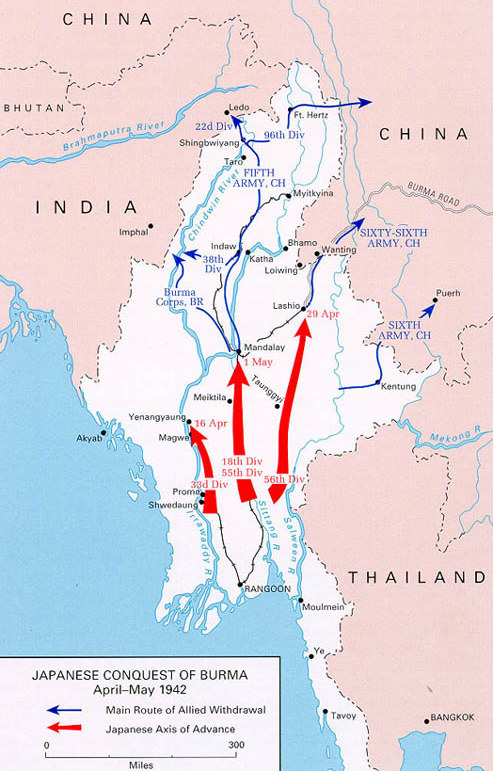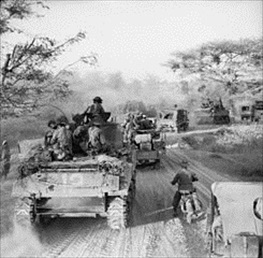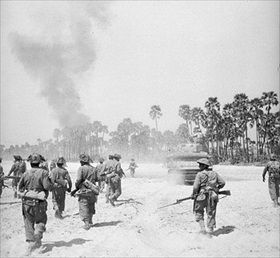BRITISH ARMY IN FIERCE BATTLE IN BURMA
Central Burma · March 4, 1945
The British Fourteenth Army was a multinational force that took part in the Burma Campaign (January 1942 to July 1945). Units were drawn from the British Army and the Indian Army, with significant contributions from Ghurkha and West and East African regiments. The Fourteenth Army has often been referred to as the “Forgotten Army” because its theater of operations had long been written off as a “sideshow,” since fighting there did not contribute to the defeat of Japan.
For most of the Army’s existence, it was commanded by Lt. Gen. William Slim, one of the most extraordinary generals of his generation. After the March 7, 1942, fall of Rangoon (or Yangon), capital and port city of the British colony of Burma (also known today as Myanmar), the Allies attempted to make a stand in the north of the country. Operations in upper Burma over the remainder of 1942 and 1943 were a study in military frustration due largely to the “Germany First” approach adopted by policymakers in London and Washington.
In 1944 the Japanese Army in Burma attempted to invade British India (the Imphal and Kohima campaigns named after two small towns that were home to British frontline garrisons). The Imphal operation, when finally broken off early in July 1944, was the greatest military defeat on land to that date in Japanese history, a defeat brought on partly by disease that ravaged Japanese ranks and partly by superior British intelligence.
On this date in 1945, after a four-day ferocious battle, Gen. Slim’s Fourteenth Army took the central Burmese town of Meiktila, an important line-of-communication center for the Japanese. Mandalay, the old royal capital of Burma, was the Fourteenth Army’s next objective, and it fell on March 20, 1945, though the Japanese held the former citadel, called Fort Dufferin, for another week. Much of the historically and culturally significant portions of Mandalay were burned to the ground in scenes reminiscent of the destruction the Japanese inflicted on the Philippine capital of Manila in the same month. Between the two Burmese battles—Meiktila and Mandalay—most of the Japanese forces in the British colony were destroyed, allowing the Allies to later recapture Rangoon, which the Japanese had evacuated, and reoccupy most of the country with little organized opposition.
1942 Japanese Conquest of Burma and the British Fourteenth Army’s Retaking of Meiktila in March 1945

Above: Map showing Japanese inroads in Burma (heavy red lines) and British
routes of withdrawal (thin blue lines), April–May 1942.
 |  |
Left: Sherman tanks and trucks of Gen. William Slim’s Fourteenth Army advance on Meiktila, Burma, March 1945. (Meiktila, south of Mandalay, is to the immediate left of the middle red arrow in the map above.)
![]()
Right: Men of the British Indian Army (6/7th Rajputana Rifles) advance behind Sherman tanks during the assault on Meiktila. Overcoming immense logistical problems, Slim’s armored dash behind enemy lines seized Meiktila, cutting Japanese supply lines. At the end of March 1945, the spent Japanese 15th Army withdrew south, leaving Rangoon to the British on May 2–3, 1945, while making their way east to Thailand. On September 12, 1945, the British accepted the surrender of 680,000 Japanese soldiers still left in Southeast Asia.
Scenes from the Allies’ Two-Prong Burma Campaign, 1944–1945
![]()

 History buffs, there is good news! The Daily Chronicles of World War II is now available as an ebook for $4.99 on Amazon.com. Containing a year’s worth of dated entries from this website, the ebook brings the story of this tumultuous era to life in a compelling, authoritative, and succinct manner. Featuring inventive navigation aids, the ebook enables readers to instantly move forward or backward by month and date to different dated entries. Simple and elegant! Click
History buffs, there is good news! The Daily Chronicles of World War II is now available as an ebook for $4.99 on Amazon.com. Containing a year’s worth of dated entries from this website, the ebook brings the story of this tumultuous era to life in a compelling, authoritative, and succinct manner. Featuring inventive navigation aids, the ebook enables readers to instantly move forward or backward by month and date to different dated entries. Simple and elegant! Click 











